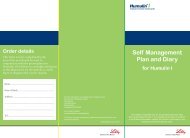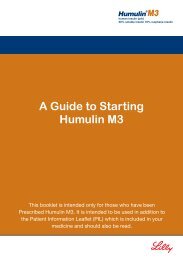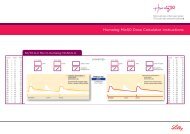Humalog Mix50 (50% insulin lispro [rDNA origin] injection ... - LillyPro
Humalog Mix50 (50% insulin lispro [rDNA origin] injection ... - LillyPro
Humalog Mix50 (50% insulin lispro [rDNA origin] injection ... - LillyPro
- No tags were found...
Create successful ePaper yourself
Turn your PDF publications into a flip-book with our unique Google optimized e-Paper software.
<strong>50%</strong> <strong>insulin</strong> <strong>lispro</strong> (<strong>rDNA</strong> <strong>origin</strong>) <strong>injection</strong><strong>50%</strong> <strong>insulin</strong> <strong>lispro</strong> protamine suspensionA Guide to Starting<strong>Humalog</strong> <strong>Mix50</strong>This booklet is intended only for those individuals who have beenprescribed <strong>Humalog</strong> Mix 50. It is intended to be used in additionto the Patient Information Leaflet (PIL) which is included in yourmedicine and should also be read.
Contents• What should I have received from the pharmacist? 3• Why have I been given this booklet? 4• What is <strong>Humalog</strong> <strong>Mix50</strong> and how does it work? 5• When do I take my <strong>insulin</strong>? 6• Who decides how much <strong>insulin</strong> I need? 7• When do I check my blood glucose levels? 8• Instructions for self-adjustment of my <strong>insulin</strong> 9• How do I inject my <strong>insulin</strong>? 11• Preparing your <strong>injection</strong> 12• What if I forget an <strong>injection</strong>? 13• What is a hypo and why does it happen? 14• How do I deal with hypos? 16• What should I do if I feel unwell? 182
What should I have received fromthe Pharmacist?CartridgeKwikPenYou have been prescibed an <strong>insulin</strong> called<strong>Humalog</strong> <strong>Mix50</strong>.Ensure that your medicine has <strong>Humalog</strong> <strong>Mix50</strong>on the packaging, as shown aboveYour <strong>insulin</strong> should be - please tick• 3ml <strong>Humalog</strong> <strong>Mix50</strong> cartridge for use in adurable pen device e.g the HumaPen Savvio ❑• 3ml <strong>Humalog</strong> <strong>Mix50</strong> KwikPen (prefilled pen device) ❑3
Why have I been given this booklet?You have been prescribed <strong>Humalog</strong> <strong>Mix50</strong> (your<strong>insulin</strong>), to help you manage your diabetes. The aimof this booklet is to allow you to learn more aboutyour <strong>insulin</strong> and help YOU make the right decisionsabout adjusting your <strong>insulin</strong>, and taking control ofyour diabetes.It is intended to be used in addition to the patientinformation leaflet found in your medicine pack.4
Instructions for self-adjustmentof my <strong>insulin</strong>When testing your blood glucose, if you haveconsistently high readings for more than three daysat any testing point, then you will need to adjust your<strong>insulin</strong>.Your healthcare professional will explain to you how toadjust your <strong>insulin</strong> and will complete the following tablefor your needs.If your results fall outside of your target range asdescribed on page 8, the following tables will enable youto identify which <strong>insulin</strong> <strong>injection</strong> will need adjusting andby how muchAdjustInsulinDose by... UnitsBeforeBreakfastEveningInjection<strong>Humalog</strong> <strong>Mix50</strong> twice dailyAfterBreakfastBeforeLunchAfterLunchMorning Injection.BeforeEveningMealAfterEveningMealBeforeBedEvening InjectionDuringNight9
<strong>Humalog</strong> <strong>Mix50</strong> three times dailyBeforeBreakfastAfterBreakfastBeforeLunchAfterLunchBeforeEveningMealAfterEveningMealBeforeBedDuringNightEveningInjectionMorning InjectionLunchtimeInjectionEvening InjectionAdjustInsulinDose by... UnitsDose reduction is recommended if any results areconsistently less than 4 mmol/L (hypo) at any time.10
How do I inject my <strong>insulin</strong>?Your healthcare professional will explain how toinject your <strong>insulin</strong>. Injection is usually via approvedpen devices.Where do I inject?Your <strong>insulin</strong> can be injected in the places shownbelow. The site of the <strong>injection</strong> should be rotatedwithin the chosen area to prevent complicationsdeveloping at your <strong>injection</strong> site and aid <strong>insulin</strong>absorption. Check with your healthcare professionalwhich are the most suitable <strong>injection</strong> sites.11
Preparing your <strong>injection</strong>Its important that before you inject your <strong>insulin</strong> yourotate it between the palms of the hands ten times andinvert it through 180° ten times immediately before use.This is to ensure the <strong>insulin</strong> is mixed properly. It shouldappear uniformly cloudy or milky.The image above is a KwikPen, if you have beenprescribed <strong>Humalog</strong> <strong>Mix50</strong> in a cartridge you shouldload the cartridge into the pen device and then mixsimilarly to that shown above.12
What if I forget an <strong>injection</strong>?Forgetting your <strong>insulin</strong> is rarely an emergencysituation. Seek advice from your diabetes team.The advice will vary depending on when you haverealised you have forgotten to take your <strong>insulin</strong>What if I cannot remember if I had my <strong>insulin</strong>?If you are in any doubt, do not take your <strong>insulin</strong> again.In both cases your blood glucose may run a littlehigher after the <strong>injection</strong> you have forgotten.Do not worry.It is very important that youknow the name of your pen device,your <strong>insulin</strong> and the nameof your blood glucose meterMy <strong>insulin</strong> is:My pen is:My blood glucose meter is:13
What is a “hypo” and why does it happen?A blood glucose reading of 4mmol/L and under ishypoglycaemia (a “hypo”). A hypo occurs when theblood glucose level falls too low. People feel differentthings when a hypo is starting, you may also findsome of your hypos feel different from others.A hypo can happen for a number of reasons:• If you’ve missed a meal or had one later than usual• If you’ve not had enough food or eaten less foodthan normal• If you’ve had more <strong>insulin</strong> than necessary• If you’ve been more active than usual• If you’ve been drinking alcohol• If you’ve experienced extremes in temperature,either hot or coldIf your diabetes is well controlled, occasional hyposare a normal part of life for people with diabetes, butthey shouldn’t take over your life. If you are havingfrequent hypos, speak with your diabetes team.14
Hypos begin quickly, but there are usually warningsigns. Symptoms can vary from person to person,but may include the following:• Sweating• Thumping heart• Looking pale• Weakness or tiredness• Pins and needles sensation• Dizziness/ feeling tipsy, drunk• Disturbed vision• Mild confusion• Slurred speech• Hunger• Aggression or altered behaviour• HeadacheIf hypoglycaemia isn’t corrected it can lead to moreserious conditions such as loss of consciousness.15
How do I deal with hypos?If you experience a hypo, you should deal with it bytaking 15-20g of quick acting carbohydrate such as:• 5 - 7 Dextrosol ® tablets or,• 90-120ml of <strong>origin</strong>al Lucozade ® or,• 150-200ml of pure fruit juice such as orange juiceYour healthcare professional may also advise you ofquick acting carbohydrate such as:It is advisable to re-check your blood glucose levelafter taking carbohydrate to ensure your bloodglucose levels are rising.16
If you are not about to eat a meal, ensure you eat10-20 grams of slow acting carbohydrate, to maintainyour blood glucose levels until you next eat.This can be:• half a sandwich• fruit• a small bowl of cereal• biscuits and milkYour healthcare professional may also advise you ofslow acting carbohydrate such as:The exact quantity will vary from person to person.Remember to carry your identity card and glucosetablets with you in case of an emergency.If you have regular hypos consider adjusting your<strong>insulin</strong> and/or contacting your nurse or doctor.17
What should I do if I feel unwell?A number of common illnesses can cause your bloodglucose to rise. When you are unwell you may notwant to eat or take your <strong>insulin</strong> treatment as normal,but it is important to follow these basic rules:1. Keep on taking your <strong>insulin</strong>However ill you feel and however little food youare eating, according to your blood glucose levelsyou may still need <strong>insulin</strong>. Sometimes in thesecircumstances you need more than your usual dose.Ask your healthcare professional for specific adviceon what action to take when you are ill.2. Monitor your blood glucoseMonitor your blood glucose. Test at least 4 timesdaily as your blood glucose levels will indicatewhether you require extra <strong>insulin</strong> doses.3. Take carbohydrates in liquid formTake unsweetened fluids if your blood glucose ishigh. If you still do not feel like eating as your bloodglucose returns to normal then substitute food withsweetened fruit juices or drinks that contain glucose.18
Notes Page19
Side effects should be reported.This includes any possible side effects not listed inthe package leaflet. If you experience side effects talkto your doctor or other healthcare professional.Any side effects from your medication can be reported atwww.mhra.gov.uk/yellowcard.Side effects and product complaints can also bereported to Lilly: please call Lilly UK on 01256 315 000.By reporting side effects you can help provide moreinformation on the safety of medicines.This booklet has been developed and printed by Lilly as a service to patients.Eli Lilly & CompanyPriestley RoadBasingstokeRG24 9NL01256 315 000www.lillydiabetes.co.uk/patientsUKHMG00592(2) March 2014


![Humalog Mix50 (50% insulin lispro [rDNA origin] injection ... - LillyPro](https://img.yumpu.com/44269187/1/500x640/humalog-mix50-50-insulin-lispro-rdna-origin-injection-lillypro.jpg)









![Humalog Mix25 (25% insulin lispro [rDNA origin] injection 75 ...](https://img.yumpu.com/35487335/1/184x260/humalog-mix25-25-insulin-lispro-rdna-origin-injection-75-.jpg?quality=85)



